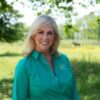Graham Land & Cattle – Gonzales, TX

Here in Texas, it’s not hard to find examples of people and places that strive to move the needle forward. Our diverse heritage brings a fusion of culture and ideas that play out in many ways–especially on our plates. The latest season of BBQuest: “Beyond The Pit” delves into the long-held traditions that makes Texas barbecue so legendary, but also explores new flavors and techniques that keep it on the cutting edge.
And it doesn’t stop in the kitchen. Innovation on ranches and operations like Graham Land and Cattle in Gonzales are helping carry the beef industry (and Texas barbecue) into the future.
Graham Land and Cattle is a feedyard–the last stop of the beef lifecycle before it is processed and hits grocery store shelves. Josh Gray, Graham Land and Cattle’s financial manager, explains their important role in raising quality beef from pasture to plate.
“The things we do here affect the quality of beef at the grocery store,” he said. “Every day the people I work with are ensuring the health of these cattle and our environment, from nutrition to land management.”
Cattle at Graham are fed under the guidance of a beef cattle nutritionist (like a registered dietitian for cows) who gets creative to repurpose things humans can’t eat to meet the cattle’s individual nutritional needs. For example, brewer’s grain sourced from local breweries is transformed from an unwanted byproduct of the beer-making process into a nutritionally-dense ingredient to be mixed in with steam-flaked corn, rice bran, cotton seed and other ingredients personalized for cattle. It’s a win-win for everyone in the entire supply chain, and shows just how efficient cattle are at upcycling to create the nutrient-dense beef we love.
According to Josh, formulating rations for the cattle is as much a science as it is an art. Bunk readers, or cowboys on horseback, ride through the pens each day to measure how much feed the cows leave “on the table” so to speak. This helps Josh’s team adjust the amount of feed and reduce waste. Cattle at Graham also sport unique I.D. tags that track feed intake and overall health of each individual animal.
Graham Land and Cattle also cares about their neighbors in the Guadalupe Valley and community at large.
“Most of the employees here are neighbors, I also live just half-mile away,” said Josh, who worked the feedyard during summers and then returned after college more than 15 years ago. It’s worth noting his family goes way back in this operation. Josh’s father was once general manager and his grandfather was involved with the business prior to 1987 when it was Harrell Cattle Company.
“As a company, we have taken raw land and turned it into a productive industry for this area over the years,” Josh explains. “We strive to be good stewards of our resources and a supportive part of this community – for our employees, customers, neighbors, and of course, the cattle and the land.”
The feedyard recycles manure to make their own fertilizer, and tests the soil regularly to meet environmental requirements. According to Josh, these innovations are part of the bigger picture that keep Graham Land and Cattle going.
“The beef community – the cowboys, the ranchers, the fabricators, the equipment operators – these individuals are some of the greatest rewards of working in the beef industry. It’s true that some days are difficult,” said Josh. “But you find the problems and solve the challenges together, and that’s fulfilling.”
When it comes to eating beef at home, Josh says he’s a huge fan of skirt steak sliced up for tacos. And if you’re ever visiting or road-tripping through Gonzales, he suggests stopping at Baker Boys BBQ for brisket, ribs, and homemade beef sausage. “They’ve been named in the Texas Monthly ‘Top 50 Best BBQ Joints’ he elaborates, “and it’s where I take all our feedyard customers when they come into town.”
Josh is looking forward to Graham Land and Cattle being featured in Season 3 of Beef Loving Texans’ original series, BBQuest. Click here to watch the episode, “Legacy & Tradition”.
“I want the public to appreciate what the beef industry does to bring a quality product to market,” he said. “It’s a community of men and women who care.”






